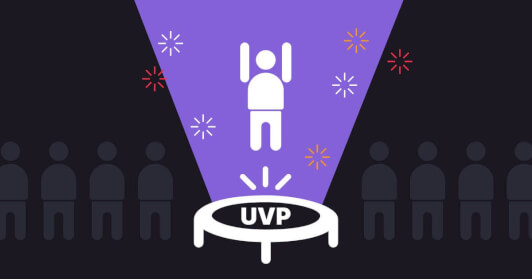What makes a translation buyer choose your LSP over a competitor? Your language pairs? Your specializations? Your ordering and delivery process? Whatever it is, it will be something that the customer deems to be a significant advantage over your competitors. Every agency looking for long-term sustainable growth should develop a Unique Value Proposition as a part of their LSP strategy.
What’s a Unique Value Proposition?
Your Unique Value Proposition or UVP is what differentiates your LSP from other similar translation services. If a buyer comes to you for translations but hasn’t researched any of your competitors, then you just got really lucky! But know that they didn’t choose you because they thought you were offering something better than a competitor. Most buyers will do a fair amount of research before picking an LSP so whatever makes them choose you over all the other options is what they’ll perceive as your Unique Value Proposition.
Note that your Unique Value Proposition is not about your LSP’s features or services per se. It’s totally reliant on your audience’s perception of the benefits you bring. So, start by identifying what’s different about you and then make sure this differentiation is perceived as value by the potential customer and, ultimately, as the best solution to the problem they have.
UVP challenges and solutions
Some LSPs claim that quality or good customer service is their Unique Value Proposition, when in fact, these are just basic standards that all LSPs should provide — they don’t add value in any unique way, they are just offering what any customer would expect from an LSP.
So how can LSPs truly differentiate themselves? One obvious way is by specializing in a certain vertical or industry. LSPs that only work in a certain field like law, medicine, or finance, will find it a lot easier to stand out from the crowd.
Another option is focusing on fewer language pairs, or even a single pair. The rarer the combination, the less competition you will have and the easier it will be to become the go-to translation provider for that pair. Having said this, you want to make sure that there is at least some demand for this service in the market, so do some preliminary market research first before going exclusively for such a narrow specialization.
How Continuous Localization can help
Niching down isn’t the only way to stand out. One way of facilitating the differentiation of your LSP is by adopting the most up-to-date localization processes, or what is now known as Continuous Localization. The demand for localized content is growing at such a fast pace in today’s content-focused economy that old-school LSPs are inevitably struggling to keep up. Not only is the amount of content that needs translating increasing, but the ways in which it is ordered and delivered is changing too.
Tech and workflow adaptability
For LSPs still using the same localization methods we used twenty or thirty years ago, the time it takes to manually accept, assign, manage, process, and deliver orders can become a huge bottleneck in their workflows. By implementing Connected Translation, whereby the translation process is connected at multiple levels within the LSP and with the customer’s content existing workflows, your LSP can provide a faster and more refined localization experience for the buyer. This usually involves integrating CMSs and repositories, enabling collaborative translation, and sometimes even integrating dedicated payment solutions.
The fact that you can immediately respond and adapt to the customer’s tech stack may be the Unique Value Proposition in itself if they are struggling to find the right translation provider who can make onboarding and connecting to their content loop as seamless and painless as possible.
One-stop shop
Similarly, upping your Continuous Localization game will make it much easier for you to expand on the types of services you can offer your customers. Content today comes in a variety of forms, not just written text. Companies produce content in formats like video, infographics, and audio, all of which may require translations. Are you the LSP with the right technology and localization processes in place to offer clients an all-in-one translation service for all their media products? And can you offer additional services such as SEO and DTP?
If so, this all-in-one offering could easily become part of your UVP. Today more than ever, buyers want to work with service providers that can offer a comprehensive solution. And most will be willing to pay a little more for that comfort.
Finding your UVP: A practical example
Let’s see what an LSP’s UVP journey might look like. Say you’re an LSP offering translations in any subject area and in most European-language combinations. What’s your Unique Value Proposition? If you have one, it will probably be really impressive because you’ll have to be different to all the other generalist LSPs offering the same languages.
Most likely you don’t have a genuine UVP at this point so you decide to niche down to just one language pair: English to Italian (and vice versa). Great, you can get really good at finding the best native Italian and English translation specialists, but is that enough to have a UVP? Unfortunately, it’s likely still too hard.
You’re getting a lot of orders in finance and FinTech, and you’ve actually got two or three in-house translators who specialize in finance. So you decide to take the leap and focus exclusively on financial and FinTech translations from and to Italian. That’s already fairly niche in itself, but what’s your Unique Value Proposition that sets you apart from all the other LSPs that also offer financial translation services to and from Italian? Well, you’ve “cut down” as much as you’re comfortable with, so it’s time to “add”.
You decide to set up a client portal on your website for your clients to easily submit, receive, and pay for their orders. You try it out with your most loyal clients and discover that it cuts their translation management time in half. If no other specialized LSP can match that translation process then that could easily become your Unique Value Proposition. In other words, you’ve finally found that single value point that nobody else can offer — you’re the only LSP that provides financial translation services to and from Italian through an integrated client portal that cuts the buyer’s translation management time by 50%.
How to sell your UVP
Now you’re clear about what’s so special about your LSP, but the game changer is getting your potential buyers to see this too. Make sure you include and clearly showcase your UVP in all your brand messaging, marketing materials, website, and social media. The more you focus on this unique benefit that no one else can offer, the more your potential customers will think of your LSP when looking to solve that particular pain point.
It's not what you sell that matters as much as how you sell it!
— Brian Halligan, CEO at HubSpot
But how do you actually convince your potential customers you’re the real deal? You need proof to back up your words. And this can be hard, raw data that you can showcase, e.g. how your services help businesses meet certain KPIs, or how you cut their translation management time by 50%, or how you increase their ROI. Or you can offer qualitative proof like testimonials or case studies of happy clients explaining why they chose you and what results they got.
Be different and tell the world about it
Finding your Unique Value Proposition may be harder than you think, especially if you’re reluctant to stray from the generalist LSP path. The truth is, every business needs to find their UVP to grow sustainably so don’t be afraid to get really specific about what kind of LSP you want to be and who you want to serve. As long as you follow the market closely to ensure this differentiating factor is something that potential buyers actually need and want, you really can’t go wrong with niching down and focusing on one outstanding value point for your customers.
Subscribe to our newsletter


